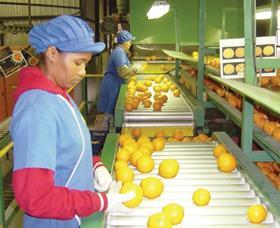
The world’s citrus producers gathered for their regular teleconference last week amidst increasing indications that 2011 is turning out to be a nightmare of a season for most. What they learnt from each other did little to boost confidence.
According to Justin Chadwick of the South African Citrus Growers Association the words problematic and difficult dominated the discussion between delegates from South Africa, Chile, Belgium, Spain, Argentina, Italy, Australia, Uruguay and Germany. There were also written contributions from Turkey and Cyprus.
“Production woes in 2011 are not restricted to South Africa,” said Mr Chadwick. “Argentina has probably been the hardest hit of all with the worst freeze damage in five years. As a result the final lemon export figure has been reduced from 260,000 tonnes to 220,000 tonnes, with perhaps some further reductions to around 200,000 mentioned at the meeting.”
He said Argentinean soft citrus exports were halted for two weeks and indications are the export volume had dropped by 5 per cent. Orange exports are down by 40 per cent due to reduced demand in Europe and Russia, which are the main markets for Argentine fruit.
Uruguayan delegates pointed out they were already facing a reduced estimate because of drought and high summer temperatures. This has been further reduced by frost in the north as well as a result of poor markets. Soft citrus is expected to be down by between 15-20 per cent; lemons by 10-15 per cent and oranges have also come down.
The odd country out was Australia where the weather has been more favourable with soft citrus anticipated to increase by 5-10 per cent and oranges up 25-30 per cent. However, poor market conditions and a strong currency could see some of the fruit being left on the trees.
Mr Chadwick said a common concern in the Southern Hemisphere is the weakening of the US Dollar and the Euro. Australia has been worst hit with the Australian dollar 32 per cent stronger in June 2011 compared to June 2010. South American and South African currencies have strengthened by between 15-17 per cent.
“Coupled with this are increasing energy, fuel and labour costs experienced by Southern Hemisphere countries,” said Mr Chadwick. “As a result a carton of fruit coming from the Southern Hemisphere needs to attract a price 20-50 per cent higher than in 2010 (in euro or US dollar terms) to be at the same level.”
He said the market reports did not lift the spirits. A large Northern Hemisphere overhang in the market meant that prices have remained depressed in all markets for all fruit, not only citrus. Spanish lemon exports in 2010/11 were 420,000 tonnes compared with 351,000 tonnes in 2010; Spanish orange exports were 1,440,000 tonnes compared with 1,260,000 tonnes the previous year and Spanish soft citrus exports increased to 1,611,000 tonnes from 1,363,000 tonnes in 2010. This was coupled with Turkish lemon exports being 10 per cent higher than in 2010; Turkish soft citrus exports 38 per cent higher than 2010 and Turkish orange exports 63 per cent higher than 2010.
“This means that there has been too much fruit in a weak market,” he said.
He added that there was a possibility that the lower Argentinean lemon exports will boost the price for lemons for those who still have product available. “Some speakers already reported improvements in prices.”
The Russian market is reported as being unstable for all citrus for the next few weeks.
Mr Chadwick said grapefruit received much attention during the discussion, with most speakers indicating that demand was continuing to decline and that they did not see much future in the category. “Argentina reported exports of just 9,000 tonnes, which could drop to zero within two years if market returns did not improve.”
He cautioned exporters to pursue realistic prices and avoid speculation. “Make sure the fruit has a home at a reasonable price and look carefully at juicing and the local options market.”
Although the meeting did not focus on the Northern Hemisphere’s 2011/12 season, some forecasts were supplied by Spain. They reported anticipated reductions in the production of Satsumas (down 15 to 20 per cent); Clementines (down 10 per cent); Navelina (down 20-30 per cent); Navelates (down 5-10 per cent) and valencia (down 10-15 per cent).
Meanwhile the South African export programme has passed the halfway mark with 52m cartons out of the total forecast of 93,9m cartons already having been shipped.



